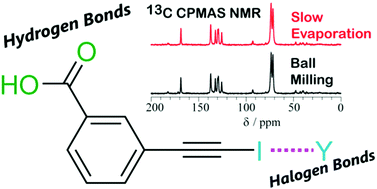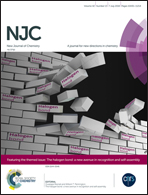Mechanochemistry and cocrystallization of 3-iodoethynylbenzoic acid with nitrogen-containing heterocycles: concurrent halogen and hydrogen bonding†
Abstract
Halogen bonding has been shown to be a versatile interaction for crystal engineering purposes, with characteristics that parallel those of hydrogen bonding. Here, we explore the potential of a new halogen bond donor, 3-iodoethynylbenzoic acid (1), which is functionalized with both halogen bond donor and hydrogen bond donor groups. We explore its crystal engineering potential by cocrystallizing it with a series of nitrogen-containing heterocycles, namely 2,3,5,6-tetramethylpyrazine, 1,4-diazabicyclo[2.2.2]octane, piperazine, and hexamethylenetetramine. In total, we report six new single-crystal X-ray diffraction structures, including those of 1 and five of its halogen-bonded cocrystals. The halogen-bonded cocrystals are further investigated using 13C magic-angle spinning solid-state NMR spectroscopy and the observed changes in chemical shifts are attributed to particular structural or crystallographic features. The 13C chemical shift of the ethynyl carbon bonded to the aromatic ring consistently decreased by several ppm upon halogen bond formation while that of the ethynyl carbon bonded to iodine increased. Furthermore, we show that these cocrystals are also readily prepared by mechanochemical ball milling, allowing for the rapid screening of cocrystal formation based on this halogen bond donor.

- This article is part of the themed collection: The halogen bond: a new avenue in recognition and self-assembly


 Please wait while we load your content...
Please wait while we load your content...